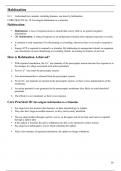Habituation
8.13 Understand how animals, including humans, can learn by habituation.
CORE PRACTICAL 18: Investigate habituation to a stimulus.
Habituation:
• Habituation: A loss of responsiveness to stimuli that convey little or no positive/negative
information.
• OR: Habituation: A reduced response to an unimportant stimulus after repeated exposure over time.
• A stimulus is only important if its threatening or rewarding, otherwise there is no need to respond to
it.
• Energy/ATP is required to respond to a stimulus. By habituating to unimportant stimuli, an organism
can concentrate on more threatening or rewarding stimuli, increasing its chances of survival.
How is Habituation Achieved?
1. With repeated stimulation, the Ca2+ ion channels of the presynaptic neuron become less responsive to
the changes in voltage associated with action potentials.
2. Fewer Ca2+ ions enter the presynaptic neuron.
3. Less neurotransmitter is released from the presynaptic neuron.
4. Fewer Na+ ion channels are opened in the presynaptic neuron, so there is less depolarisation of the
membrane.
5. An action potential is not generated in the postsynaptic membrane (less likely to reach threshold
potential).
6. The effector is not simulated, so there is no response.
Core Practical 18: Investigate habituation to a Stimulus
• Sea slugs have less neurons than humans, so their neurobiology is simpler.
• They also have large accessible neurons, so they can be easily identified.
• The sea slug breathes through a gill in a cavity on the upper side of its body and water is expelled
through a siphon tube.
• If the siphon is touched, the gill is withdrawn into the cavity (protective reflex action).
• Sea slugs have habituated to waves which stimulate the siphon.
• After a few minutes of repeated stimulation, the siphon no longer withdraws.
26




